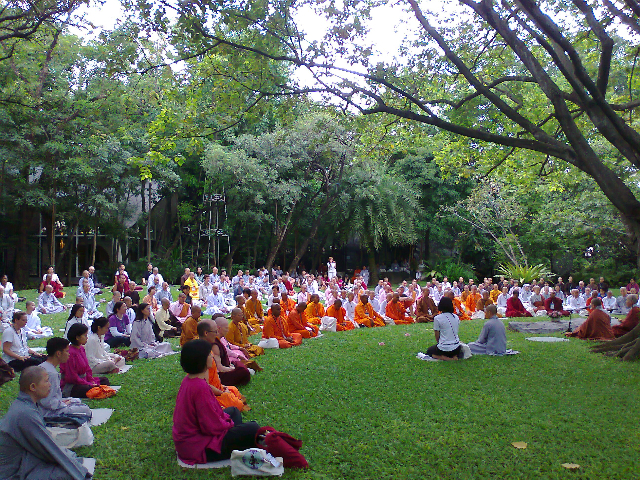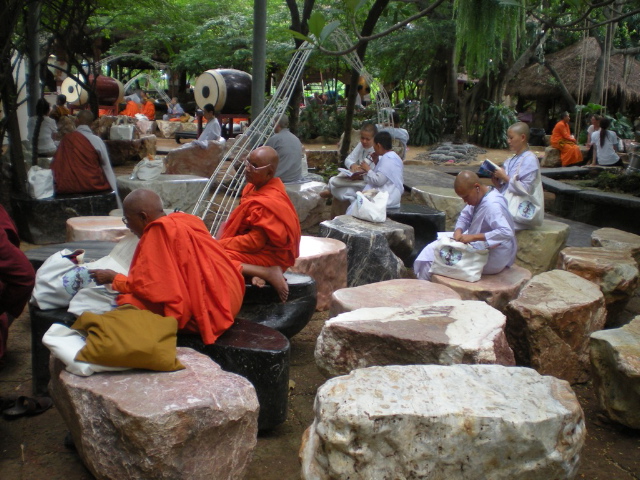The 12th Sakyadhita (daughters of the Buddha) International Conference was held on 12 -18 June 2011 at the center of Mae Chee Sansanee called Sathira Dhammasathan in Bangkok.
Sathira Dhammasathan was an ideal location for such a gathering with spaces for presentations as well as large group meditations, and all of the various interesting workshops provided. When entering the conference on the first day many people commented on the diverse groups of nuns from all around the world and the range of colors displayed in their robes–white, maroon, orange, gray, pink. Female monastic representatives from the traditions in Myanmar, Korea, Vietnam, Thailand, and India, among others, were all present. One of the main goals of these bi-annual conferences is to encourage dialogue between these groups and this was certainly accomplished with the large diversity of countries and traditions represented.
Over the six full days of the conference there were panel presentations and participatory workshops. The topics of this and past Sakyadhita conferences focused predominantly on Buddhist women, and using Buddhism for social transformation in various ways. Topics were directed toward female Buddhist practitioners and interested academics. All of the different nationalities were considered as translations of all the papers were available in book form in English, Korean, Vietnamese, Chinese and Thai, as well as simultaneous translations via headset in those and other languages.
It was the informal conversations among Buddhist women from around the world, however,spurred by workshop and panel presentations, where the purpose of Sakyadhita was realized. Nuns from Sri Lanka spoke with nuns and monks from Thailand and Vietnam and compared experiences. Nuns from Australia, New Zealand, and the USA felt less isolated as they met their dharma colleagues and received inspiration from their stories. The panel presentations were a source of discussion among the panelists as well as the audience, so some of the most interesting conversations occurred during the question and answer period. After the panel on Buddhist women and education there was a call for a centralized organizing body to raise money and regulate all of the international Buddhist colleges. Therefore questions were not always focused on research but on how to use the information for building networks and creating and developing local and international programs.
This conference is an example of the meeting of scholarship with Buddhist practice. Here activism and scholarship were aligned as panels consisted usually of both practical ideas of adding Buddhist practices to daily life as well as textual analysis of Buddhist texts and reports on ethnographic research. There were accounts of activism work from around the globe as well as thoughtful pieces that relate Buddhist concepts toward global transformation. Other main topics included success stories highlighting leading Buddhist women, as well as challenging issues concerning discrimination against Buddhist women. Therefore the conference engaged in a successful mix of practice and theory, as well as perspectives from practitioners and academics. Some panelists combine both of course, with many ordained female participants working toward or having already received higher education degrees.
Comments describing Sakyadhita conferences as unlike any other could be heard throughout the five-day gathering. Many participants have come to two or more of these and reconnect with academic friends in Buddhism and gender studies as well as monastics. This is not an exclusively Buddhist conference as female representatives from Christianity, Hinduism and Judaism also participated. This shows Sakyadhita International’s interest in creating interreligious dialogue among women who are working together to create change. The aim of this conference is to bring academics, practitioners and those who combine both together to learn from each other and about the lives of Buddhist women all over the world. This was certainly accomplished and many of the participants are already looking forward to the next meeting in 2013.
 Facebook
Facebook  Twitter
Twitter  Soundcloud
Soundcloud  Youtube
Youtube  Rss
Rss 
